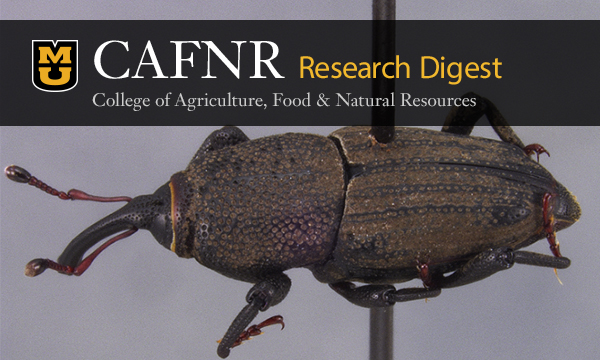|
Scott Peck named Fellow of the American Society of Plant Biologists
Scott Peck has been awarded the Fellow of ASPB Award from the American Society of Plant Biologists. Peck is a professor of biochemistry whose lab is principally concerned with how plants respond to bacterial pathogens and how plants grow when they have little access to water. The award recognizes Peck’s distinguished and long-term contributions to plant biology, particularly focused on plant defense and proteomics and his service to the Society, which includes, among other things, service as an editorial board member for more than 10 years for The Plant Cell, one of the top journals for plant biology research.
CAFNR faculty members have received the following recent grants (listed by Principal Investigator):
Kevin W. Bradley, Weed control and crop tolerance in Midwest LL-soybeans, 1/1/2019 – 12/31/2019, $6,624, AgriMetis
Pengyin Chen, Breeding Soybeans for Resistance to Mature Soybean Seed Damage, 1/1/2019 – 9/30/2019, $50,000, Mississippi State University
Daniel Downing, 2019-2020 – MO State Plan of Work, 1/1/2019 – 12/31/2020, $150,000, University of Minnesota
John Kruse, Increasing the Profitability of Missouri Crop Farmers through Improved Marketing Strategies, 4/1/2019 – 9/30/2020, $50,000, University of Nebraska-Lincoln
Thomas R. Lock, Evaluation of Urease and Nitrification Inhibitors in Tall Fescue, 3/1/2019 – 12/31/2019, $24,328, Koch Agronomic Services
Calvin Meeks, Cotton Incorporated-Cotton Specialists Partnerships: Large-Plot, Replicated Variety Evaluations-MO, 1/1/2019 – 12/31/2019, $6,000, Cotton Inc.
Henry Nguyen, Gene-to-field characterization of the regulation and function of qWT_Gm03/SAUR-FT in waterlogging tolerance and yield stability in soybean, 3/15/2019 – 3/14/2022, $410,323, National Institute of Food and Agriculture
Gary Stacey, Physiological and Molecular-Genetic Characterization of Basal Resistance in Sorghum, 9/1/2015 – 8/31/2019, $163,687, North Carolina State University
Frank R. Thompson, A Proposal to the Department of the Interior to Establish the Northeast Climate Science Center, 3/1/2018 – 7/31/2019, $21,161, University of Massachusetts
Wesley Warren, Genetic and Epigenetic Annotation of the Domestic Cat Genome, 9/1/2018 – 8/31/2021, $61,393, Texas A&M University
Wesley Warren, Enhanced Development of the Xiphophorus Model System, 10/1/2018 – 5/31/2020, $75,270, Texas State University
Mitchell Weegman, A multi-species analysis of landscape effects on individual decision-making and fitness in wetland-dependent migratory shorebirds, 4/1/2018 – 3/31/2020, $3,750, Ducks Unlimited Canada
Mitchell Weegman, Behaviour and breeding success in white-fronted geese, 4/1/2018 – 3/31/2020, $7,000, Ducks Unlimited Canada
Joseph M. Zulovich, Development of Technical Tools and Publications to Implement Energy Conservation in Animal Production Facilities, 3/23/2018 – 3/30/2020, $16,300, Clemson University
Provided by the MU Office of Research
|
